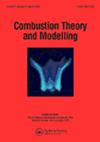重力场中流体动力不稳定预混火焰的动力学——局部和全局分岔结构
IF 1.9
4区 工程技术
Q4 ENERGY & FUELS
引用次数: 1
摘要
使用非线性Michelson–Sivashinsky(MS)方程研究了流体动力学不稳定预混火焰的动力学,该方程进行了适当的修改,以考虑重力的影响。这个问题取决于两个参数:表征可燃混合物及其扩散特性的Markstein数,以及表示浮力与惯性力之比的重力参数。使用分岔理论中的延拓方法,获得了宽参数范围内所有可能的平衡解的全面描述。结果加强了向上传播和向下传播之间的区别。在没有重力的情况下,非线性发展总是导致稳态解,即细胞火焰以恒定速度传播而不改变形状。当降低Markstein数时,随着传播速度达到上限,可以观察到振幅的适度增长。对于向上传播,平衡态也是稳定解,但其空间结构取决于导致其发展的初始条件。Darrieus–Landau和Rayleigh–Taylor的组合不稳定性产生了振幅总是更大、峰值更尖锐的轮廓,当减少Markstein数时,这些轮廓以越来越快的速度传播。对于向下传播,除了静止结构的时间周期解外,平衡状态还包括,即以恒定平均速度传播的脉动火焰。重力的稳定影响抑制了非线性生长,并导致火焰形态的时空变化,例如形成多峰静止轮廓或脉动细胞分裂和合并模式,以及传播速度的总体降低。这些状态之间的转换发生在稳定点的分叉和交换处,当减少Markstein数和/或增加重力的影响时,这一点变得更加突出。除了局部分岔特征外,通过追踪分岔点本身的连续性获得的方程的全局分岔结构揭示了定性特征,如双稳定性和滞后性的表现,和/或时间周期解的开始和维持。总的来说,这些结果展示了当重力变得有物理意义时,无论多么小,都会发生丰富而复杂的动力学。本文章由计算机程序翻译,如有差异,请以英文原文为准。
Dynamics of hydrodynamically unstable premixed flames in a gravitational field – local and global bifurcation structures
The dynamics of hydrodynamically unstable premixed flames are studied using the nonlinear Michelson–Sivashinsky (MS) equation, modified appropriately to incorporate effects due to gravity. The problem depends on two parameters: the Markstein number that characterises the combustible mixture and its diffusion properties, and the gravitational parameter that represents the ratio of buoyancy to inertial forces. A comprehensive portrait of all possible equilibrium solutions are obtained for a wide range of parameters, using a continuation methodology adopted from bifurcation theory. The results heighten the distinction between upward and downward propagation. In the absence of gravity, the nonlinear development always leads to stationary solutions, namely, cellular flames propagating at a constant speed without change in shape. When decreasing the Markstein number, a modest growth in amplitude is observed with the propagation speed reaching an upper bound. For upward propagation, the equilibrium states are also stationary solutions, but their spatial structure depends on the initial conditions leading to their development. The combined Darrieus–Landau and Rayleigh–Taylor instabilities create profiles of invariably larger amplitudes and sharper crests that propagate at an increasingly faster speed when reducing the Markstein number. For downward propagation, the equilibrium states consist in addition to stationary structures time-periodic solutions, namely, pulsating flames propagating at a constant average speed. The stabilising influence of gravity dampens the nonlinear growth and leads to spatiotemporal changes in flame morphology, such as the formation of multi-crest stationary profiles or pulsating cell splitting and merging patterns, and an overall reduction in propagation speed. The transition between these states occurs at bifurcation and exchange of stability points, which becomes more prominent when reducing the Markstein number and/or increasing the influence of gravity. In addition to the local bifurcation characterisation the global bifurcation structure of the equation, obtained by tracing the continuation of the bifurcation points themselves unravels qualitative features such as the manifestation of bi-stability and hysteresis, and/or the onset and sustenance of time-periodic solutions. Overall, the results exhibit the rich and complex dynamics that occur when gravity, however small, becomes physically meaningful.
求助全文
通过发布文献求助,成功后即可免费获取论文全文。
去求助
来源期刊

Combustion Theory and Modelling
工程技术-工程:化工
CiteScore
3.00
自引率
7.70%
发文量
38
审稿时长
6 months
期刊介绍:
Combustion Theory and Modelling is a leading international journal devoted to the application of mathematical modelling, numerical simulation and experimental techniques to the study of combustion. Articles can cover a wide range of topics, such as: premixed laminar flames, laminar diffusion flames, turbulent combustion, fires, chemical kinetics, pollutant formation, microgravity, materials synthesis, chemical vapour deposition, catalysis, droplet and spray combustion, detonation dynamics, thermal explosions, ignition, energetic materials and propellants, burners and engine combustion. A diverse spectrum of mathematical methods may also be used, including large scale numerical simulation, hybrid computational schemes, front tracking, adaptive mesh refinement, optimized parallel computation, asymptotic methods and singular perturbation techniques, bifurcation theory, optimization methods, dynamical systems theory, cellular automata and discrete methods and probabilistic and statistical methods. Experimental studies that employ intrusive or nonintrusive diagnostics and are published in the Journal should be closely related to theoretical issues, by highlighting fundamental theoretical questions or by providing a sound basis for comparison with theory.
 求助内容:
求助内容: 应助结果提醒方式:
应助结果提醒方式:


